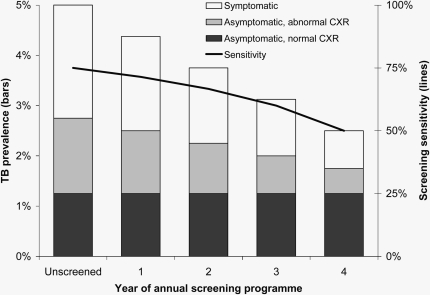Figure 1.
Schematic of the likely impact of an annual active case-finding program of symptom screen and chest radiograph on tuberculosis prevalence and sensitivity of the screening. Prevalent tuberculosis is divided into symptomatic tuberculosis disease, asymptomatic tuberculosis disease with radiographic abnormalities, and asymptomatic tuberculosis disease with no radiographic abnormalities. Assumptions: (1) Tuberculosis prevalence at final year is 2.5% and is 30% symptomatic, 20% asymptomatic with radiographic abnormalities, and 50% asymptomatic with no radiographic abnormalities, as reported in this article. (2) This is assumed to represent an open cohort of miners who are regularly screened for tuberculosis when joining the workforce and then at regular intervals after this. Hence, prevalence of tuberculosis disease that is asymptomatic with no radiographic abnormalities has remained static in the presence of the screening program. (3) The screening program has reduced the prevalence of symptomatic disease and asymptomatic disease with radiographic abnormalities at the same constant rate, producing the same linear trend in declining prevalence. (4) Sensitivity of the screening program is defined as the proportion of disease that is symptomatic plus the proportion of disease that is asymptomatic with radiographic abnormalities (i.e., it is the proportion of all true active disease that can be detected by symptom and radiographic screening). (5) For illustrative purposes, it is assumed that tuberculosis prevalence was 5% before the screening program. CRX = new or changing radiological abnormality; TB = tuberculosis.

